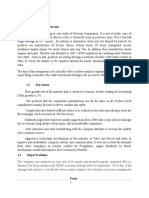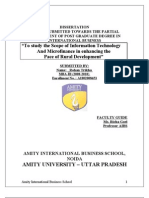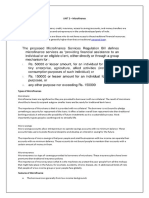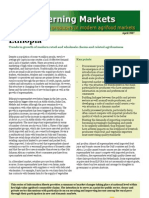IJV MARLEY Automotive
IJV MARLEY Automotive
Uploaded by
Umer HamidCopyright:
Available Formats
IJV MARLEY Automotive
IJV MARLEY Automotive
Uploaded by
Umer HamidCopyright
Available Formats
Share this document
Did you find this document useful?
Is this content inappropriate?
Copyright:
Available Formats
IJV MARLEY Automotive
IJV MARLEY Automotive
Uploaded by
Umer HamidCopyright:
Available Formats
THE FORMATION
OF AN INTERNATIONAL
JOINT VENTURE
The Formationof an International Joint Venture: MarleyAutomotive Components
RANDALL SCHULER, Research Professor, Stem School of Business, New York University; PETER DOWLING, Associate Director, Graduate School of Management, Monash University, Australia; HELEN DE CIERI, Lecturer, Graduate School of Management, Monash University, Australia
In Maidstone and Lenham in Kent, and Bitton near Bristol, England, is the operation of Marley Automotive Components Ltd. In the late 1980s it entered into an international joint venture (IJV) with the US company, Davidson Instrument Panel - Textron of Portland, New Hampshire. An earlier article by the authors examined Davidsons perception of the IJV, including their reasons for the joint venture, the critical human resource issues they were facing and how they were planning to deal with several unfolding human resource issues. This article now portrays Marleys perceptions of the same issues. The purpose in using this case study to describe IJV issues is to offer information on human resource issues to readers considering an IJV as the route to globalization. Hopefully, this information will help companies to increase the chances of a successful IJV experience. Because of increasing globalization and its attendant costs and risks, many firms are entering into international joint ventures (IJV). Although joint venture formation is proving to be an integral part of business strategy for multinational firms such as Glaxo, Grandmet, IDV, and Thorn-EMI, entering and operating them successfully is by no means a sure thing (Main, 1990). Research indicates that the failure rate of IJVs is between 50 and 70 per cent (Harrigan, 1986; Levine and Byrne, 1986). Some of the most significant barriers to success involve people issues - issues relating to international human resource (HR) management. Consequently, these issues are the focus of this article. Specifically, this article describes many of the international human resource issues associated with forming and managing IJVs. It does this through an intensive case study of an IJV in its early stages of formation and development. It addresses critical start-up issues from the view of the British partner, Marley Automotive Components Ltd. These are the same issues addressed from the view of the US partner, Davidson Instrument Panel reported in an earlier article (Schuler et al., 1991). Given that the IJV has developed since our first article, this article also addressed several other unfolding HR issues identified in that first article.
The Parents: Marley PLC and Davidson-Textron
Marley PLC
Marley is one of the leading manufacturers of building materials in the United Kingdom and has similar operations in many countries throughout the world. Marleys products extend from roof tiles, roofing felt, bricks, aerated concrete blocks and concrete paving to pvc flooring, plastic plumbing and drainage goods. Marley also derives part of its profit stream from property transactions by exploiting the value of sites surplus to operational requirements. In addition, Marley is recognized and well-established as a major supplier of quality components to the European motor industry. The particular division that deals with the motor industry is called Marley Automotive Components Ltd. This division employs approximately 1,400 workers out of a total Marley workforce of 11,000.
304
EUROPEAN MANAGEMENT JOURNAL Vol 10 No 3 September 1992
TI- E FORMATION --
OF AN INTERNATIONAL
JOINT VENTURE
The nature of the automobile industry has changed drastically during the past 20 years, and the effects have been felt by all auto makers. As the automobile industry hrs become globalized, success has turned on quality products that fit right and perform smoothly and nliably. But while quality has become a major concern to the auto industry so have cost and innovation. New products and new technology are vital to success, but without cost reduction new products cannot be offered at competitive prices. Tile characteristics of the auto industry are, of course, reflected in all companies supplying it. Marley Auton- IJtive Components Ltd. is no exception. To succeed, they must adapt to the demands of the new environrnenl:. Doing so will bring rewards such as market share al-d even more important perhaps, an extensive, cooperalive relationship with major automobile manufacturers. E-sentially gone are the days of the multiple bidding system, where winning meant delivering at the lowest cost, with no assurance that the next year will be the silme. Today, the automobile companies use sole sourcing for many of their supply needs. Accompanying this is a greater sense of shared destiny and mutual cooperation: T,le component suppliers are having to change with the times. 77e multinational car manufacturers increasingly want to deal with multinational suppliers, giving them responsibility for tlk design and development of sub-assemblies in return for sil@e supplier status (Financial Times, 1 March, 1990, p. 8). Trms, it is not unusual to have design engineers from suppliers doing full engineering design of the compl nents they will supply to their customers. An important aspect of the new cooperative, sole sourcing arrangement adopted by automotive markers is the willingness to conceptualize and form longer-term relationships. For Marley Automotive this meant the olportunity to establish an international joint venture. In the summer of 1989, Marley agreed to establish an 1JV to supply instrumentation panels to a Ford Motor Company plant in Belgium starting in 1993. They chose at, their partner for this venture the US firm, Davidson Instrument Panel.
its operations to Dover, New Hampshire, in the 1950s. Its headquarters now are located in Portsmouth. A staff in Portsmouth of fewer than 50 oversees the operations of two manufacturing plants, one in Port Hope, Ontario, and the second in Farmington, New Hampshire. The lOOO-person operation in Port Hope is unionized, and the 900-person operation in Farmington is not,
The IJV: Davidson-Marley
BV
By way of review and update, Davidson Marley BV, the name of the IJV, is a 50-50 partnership between a US firm and a British firm. It is located in Born, The Netherlands. Situated near Maastricht Airport, the location was selected because it is near its primary customer, Ford. Proximity to Ford was important, because the company required its sole source suppliers to meet its just-in-time inventory requirements. The location was also selected because of favorable accommodation by the local authorities and the fact that it is close to the Netherlands Car BV production plant (a potential customer). The facility is being constructed so that expansion can be easily incorporated and approved by the local council. The plot of land is sufficient for expanding by a factor of at least four. There were several reasons for the IJV between Marley and Davidson. First, Ford Europe asked Marley (who had been supplying its needs for the Sierra line in the UK) to supply its needs for its world car to be produced at the Genk plant. Consistent with the world car concept, however, Ford Europe wanted worldwide sourcing. A joint arrangement with Davidson Instrument Panel made a great deal of sense. It filled the worldwide sourcing requirement and it was a company Marley knew and trusted. Marley had been a licensee of the Davidson technology for instrument panel skins and the foam injected to give it shape and substance. This long-term arrangement had given each other time to get acquainted and learn about the others management style and philosophy. The compatibility in their styles provided confidence that an IJV might be successful. They were also compatible in what they could contribute to an IJV. Marley had marketing skills, knowledge of the European market and the ability to oversee construction of the new facility and provide administrative support. Davidson had the technological expertise and complementary administrative skills. Another reason for the IJV was to share the risk of a new venture. While Davidson wanted to get into Europe and Marley wanted to expand its automotive business, there was no guarantee that Ford would be successful in Genk. Marleys primary businesses are constructionrelated. To reduce its dependence on the construction cycle, it had decided to expand its automotive business. However, Marley did not want to do this without minimizing the risks. The sharing of rewards was worth the sharing of the risks with a long-term business associate. 1992 305
Davidson Instrument Panel
Dividson Instrument Panel is one of 33 divisions of Ti:xtron, an $8 billion conglomerate headquartered in P .ovidence, Rhode Island. Davidson Instrument Panel and its two sister divisions, Interior Trim and Exterior Tim, make up Davidson-Textron. All three divisions at.? component suppliers to the automotive OEMs (tmriginal equipment manufacturers). Davidson-Textron is the largest independent supplier of instrument panels fc r the US automobile industry. Originally begun as a maker of rubber products for drug sundries in Boston in the early 185Os, Davidson moved EU .!OPEAN MANAGEMENT JOURNAL
Vol 10 No 3 September
THE FORMATION
OF AN INTERNATIONAL
JOINT VENTURE
A joint venture with Davidson at a greenfield site in Born also offered Marley the opportunity to introduce a new management style and structure. During the 1980s more than 100 Japanese firms have established operations in the UK. In doing so they have implemented their human resource practices of workforce flexibility, minimal job classifications and use of teams with a total quality strategy. Though practically unknown in British industry, including Marleys other operations, these practices seemed to be working well. These practices are described in extensive detail by Peter Wickens, the Personnel Director of Nissan Motor Manufacturing UK (1988). The opening of the greenfield site in Holland, and also the creation of another joint venture in the UK with a Japanese company, offered Marley the opportunity to learn more about the Japanese policies and practices and possibly extend them to other operations. This desire was certainly consistent with Davidsons methods of operations, since it has implemented many similar practices in its plants in New Hampshire and Ontario, Canada. In deciding upon the IJV arrangement, Marley and Davidson had a choice here: they could either build a greenfield site or take over a brownfield site. While the brownfield option is faster and avoids all the aspects of construction, the two partners thought it was more important to build to their own specifications. It was critical to both that everything be designed to be compatible with a teamwork, flexible job assignment-orientation. A final reason for the IJV location was the potential it offered for competitive flexibility. Locating the plant in Born places it near Audi, Volkswagen, Mercedes and Volvo operations. While these companies often supply their own instrument panel needs, Davidson-Marley BV could potentially offer a better product at a lower price. To help develop this potential, Marley established a small marketing company. While not meant to be exhaustive, these were the major reasons for the IJV from Marleys perspective. They are certainly consistent with Davidsons motives and with those suggested in the literature (Datta, 1989; OReilly, 1988; Gomes-Casseres, 1989; Harrigan, 1987a; 1987b; Shenkar & Zeiia, 1987; and Main, 1990). Nonetheless, this does not ensure success nor diminish the risk of failure.
Both Marley and Davidson think that they can overcome the odds of failure in their IJV. Much of their confidence rests on the fact that they know what it takes for a good partnership to survive and flourish (as illustrated in Exhibit 1). Despite the many positive features of the Davidson Marley BV IJV, there is a consensus that the very nature of joint ventures contributes to their failure - they are a difficult and complex form of enterprise (see Shenkar & Zeira, 1987%; Main, 1990; Brown, 1990). As described in our earlier article (Schuler et al., 1991), the critical issues which IJVs face revolve around control, conflict, goals, management styles and degrees of commitment. Who controls the IJV - from its inception through to the early critical staffing appointments - can lead to failure. The Davidson Marley BV IJV has a board of directors with two members from each parent. All major decisions are to be decided by this board. Whenever local Dutch management or their staff encounter key issues, the board decides. To ensure that IJV development and production deadlines are not compromised, Ford requested that Marley retains one less share in voting on major issues until production starts in January 1993. This arrangement would help address any critical issues of control and conflict if such were to arise during the start-up period. Other positive factors included joint selection of the general manager and human resource manager, and an arrangement whereby Marley supplies the local marketing knowledge and makes the arrangements with the local suppliers, while Davidson supplies the technology and the financial systems (including the financial controller for the operation). These arrangements thus remove many potential disagreements and conflict and form part of the IJV agreement. Thus, errors of omission are avoided by extensive discussion of issues and formal recording of all agreements. In terms of goals, management styles, and degrees of commitment, Marley believes that it has compatibility
2. Co-operation as equals (based on parity, no domination 3. Openness, mutual trust and respect of others as persons 4. 5. 6.
7. d. 9. 10. and their values, capabilities and objective understanding of their intentions Building on each others strengths Reducing each others limitations Each has something the other needs (resources, access, etc.) Pooled capabilities and resources permit taking on tasks neither could do alone Two-way flow of communication (breakthrough of communication blocks) Mutually perceived benefits Commitmenr of leadership and middle management to find some shared values, without ignoring the fact that they are not identical Co-learning flexibility A win-win orientation or paternalism)
1. Shared objectives
(a joint mission)
Reducing
the Risk of IJV Failure
and
Managing IJVs can be very difficult. The difficulties, thus the reasons for failure, include;
Partners cannot get along; Managers from disparate partners with the venture cannot later work together; Managers within the venture cannot work with the owners managers; Partners simply renege on their promises; The markets disappear; and The technology involved does not prove to be as good as expected. 306 EUROPEAN
11. 12.
Exhibit 1
What is a good partnership? JOURNAL Vol 10 No 3 September
I
1992
MANAGEMENT
Tf IE =ORMATION OF AN INTERNATIONAL JOINT VENTURE -v. ith Davidson on these three issues. It is important that f: rms interested in IJVs give serious consideration to the degree of cultural homogeneity, This is particularly the c,lse with regard to North American and Western European countries which share a similar Western cultural heritage. These cultural similarities tend to (Ibscure difficulties. Such obfuscation is all the more likely when the differences are subtle and not obvious d luring initial negotiations. For example, when dealing bjith Asian firms, because Western managers expect differences, they will be more sensitive to cultural diversity. When dealing with firms which are perceived tc be culturally similar, managers will be less sensitive to differences which while being subtle are still important (Brown, 1990). P s a case in point, there are important differences in l;inguage usage between English-speaking countries: i\ mericans tend to use the term plant to refer to the building in which operations take place and machinery i!: located, while the British use the term plant to include machinery. Natural wastage means voluntary rc+gnations and retirements in the UK but something rather different in the USA! It is important that both pirties to a joint venture clearly define key terms early on in discussions to minimize the problems attendant Mith miscommunication. This suggests that firms entering into a joint venture establish a glossary of terms nngardless of whether they think they have a common lr nguage. Where differences in definition exist or in bvoader matters such as what selection methods to use, it seems advisable to go with local custom. T ems while it appears as if Marley and Davidson are on top of the critical issues that can give rise to IJV failure, tk ey still face many human resource issues that are bt!ginning to unfold in the evolution of their partnership. These issues include the assignment of managers, trrmsferability of human resource, managers timespending patterns, human resource competency, management loyalty issues, and career benefits and pl,mning (Shenkar and Zeira, 1990). The following sections show Marleys views on these issues. , UK firms are still using references as proof of someones fitness to do the job. More than 70 per cent of UK firms use them compared with just over 11 per cent in France Personnel Today, February 5, 1991, p. 5). In selecting the general manager for the IJV, Marley gave significant weight to experience in manufacturing. Interviews were used to evaluate the degree of fit with the operating style and management philosophy of the parents. Employment tests such as aptitude and personality were not used. Once appointed, the general manager participated in selection of the IJVs human resource manager in February 1991, using a similar process. These managerial appointments coincided with the final property purchase and ground breaking for the new plant. While both of these individuals could have been brought in even earlier to achieve greater feelings of ownership and involvement, this was not done due to cost considerations and the need to carry out these initial recruitment assignments jointly. However, this group has now been given the freedom to select, appraise, train and compensate the 250-300 employees who will be hired by August 1992. The current, relatively high unemployment rate in this region (around S-9%) should ensure a sufficiently large applicant pool. Although Marley had nominal lead responsibility for initial recruitment, the strategy for recruitment, training and compensation was developed jointly by senior human resource executives at Davidson and Marley agreed upon by the Davidson Marley board.
Transferability
of Human Resources
The Assignment
of Managers
The general manager for the IJV has been selected. He was selected by both parent firms from three Dutch finalists identified by the search firm Spencer Stuart. The process was done in a way consistent with European practices. Marley recognized the importance of adjusting to the employment practices of the host country rather than just imposing parent country pr61ctices on the otherwise local (i.e. European) operations. While there is considerable divergence with rer;ard to the development of relatively high minimum st<jndards of employment conditions as a consequence of European integration, there is divergence in terms of both specific human resource practices and implementation of HR policies. For example in comparing the UK and France on the use of reference checking:
Both parent firms are committed to the success of the IJV and are transferring experienced employees to the IJV. Even with the most systematic planning process, unforeseen events will occur. For example, the engineers assigned to design the plant were supplied by Davidson. While highly qualified, they calculated measurements in feet, inches and US gallons. The local Dutch engineers had to convert these non-metric measures when letting contracts to Dutch firms and gaining approval from local authorities. Since Davidson will supply the financial controller, US accounting procedures will be used and a corresponding set of accounts will need to be established to meet Dutch auditing requirements.
Allocation of Start-Up Responsibilities
Initially, IJV staff will need to focus on immediate, shortterm issues in establishing the joint venture. The IJV staff are not under pressure to produce an immediate profit since the business plan allows for a reasonable time horizon to achieve profitability. Marley has established a sales and marketing group in The Netherlands for the IJV to look for new contracts. Both parent firms will offer training programs and support, including tech307
EUROPEAN MANAGEMENT JOURNAL Vol 10 No 3 September 1992
THE FORMATION OF AN INTERNATIONAL JOINT VENTURE
nical training for key employees who will in turn train the other employees. Start-up costs will be shared by both parent companies.
I 1. They have long term objectives, we dont. 2. They get more than they give. 3. Their strengths (market access) were overestimated. 4. We dont communicate any more; we just let them do their thing. 5. They compete with us more than they co-operate. 6. They (or we) havent assigned the best people. 7. Our combined decision making is too slow, compared to competition. 8. We are not organized to learn from them, (or our people dont feel they can learn much from them) but they absorb everything we give them. 9. We have agreed that the best way to work is not to work together. 10. They are developing organizational capabilities which will make us unnecessary in the future. 11. Whoever cooked up this deal was pretty naive. 12. Our commitment to the success lo this partnership is declining rapidly: mutual trust and respect are minimal.
Conflicts of Loyalty
For both parent companies, the work of the planning teams is essentially completed. The financial controller (a US expatriate) is scheduled for a three-year term after which a local will take over. The staff will then be entirely Davidson-Marley BV, and conflicts of loyalty to either parent company should be minimal - particularly as the venture grows and achieves success, according to Mr. Chris Ellis, Business Development Director of Marley. The general manager and his key staff members are employed by Davidson-Marley BV and as such have career paths anchored within the joint venture rather than the parent companies.
Exhibit 2
Danger signs in partnerships
Progress to Date
To date, the two parent companies of Davidson-Marley BV appear to be benefitting from a careful planning process and a longer-term perspective with regard to profitability. Although trial production runs are just beginning at the time of writing, there have been no obvious signs of partnership dissolution or disaster. Nonetheless both parents are monitoring their relationship, checking for danger signals of a deteriorating relationship including the existence of statements such as those listed in Exhibit 2.
related to the quality of the relationship between the two partners, and the human resource decisions which flow from the relationship. We believe the Davidson-Marley BV case is a good example of an IJV where both partners have worked hard to develop the initial relationship and have taken human resource issues into consideration throughout the planning process. While this does not guarantee that Davidson-Marley BV will be successful, we believe the behaviors of the parent firms to date are good predictors for the future success of the IJV.
Note
The authors express their appreciation for the support provided by a research grant from the Human Resource Planning Society, New York, and for the generous time and assistance from Chris Ellis, Business Development Director and Norman Taylor, Personnel Manager, both of Marley Automotive Components Ltd.
Conclusion
For an increasing number of firms in many countries, going international is no longer a choice - regardless of firm size or product. The world has become far too
interconnected for many products and services to be offered within a domestic market context only. Faced with this reality, many firms in the advanced western
References
Bere, J.F. Global Partnering: Making A Good Match, Directors and Boards, 1987, 11 (2), 16. Berlew, F.K. The Joint Venture - A Way into Foreign Markets, Harvard Business Review (July-August 1984), 48-54. Brown, R. J. Mixed Marriages, International Management (December 1990), 84. Brown, R.J. Testing Times, Personnel Today (February 5, 1991), 5. Datta, D.K. International Joint Ventures: A Framework for Analysis, Journal of General Management, 1989, 14 (2), Drucker, P.F. The New Realities (New York: Harper & Row, 1989). Gomes-Casseres, B. Joint Venture Instability: Is it a Problem? Joint Ventures in the Face of Global Competition, Sloan Management Review, Spring 1989, 17-25. Harrigan, K.R. Managing For Joint Venture Success (Boston, MA: Lexington Books, 1986). Managing Joint Ventures, Management Review, 1987a, Strategic Alliances: Their New Role in Global Competition, Columbia ]ournal of World Business, 1987b, Hyatt, J. The Partnership Route, INC. (December 1988), 145-148. Lasserre, P. Strategic Assessment of International Partnership in Asian Countries, Asia Pacific Journal of Management, September 1983, 72-78.
22 (2), 67-69. 76 (2), 24-42. Columbia Journal of World Business, 1987, 22 (2), 97-102. 78-91.
economies are seeking to establish their presence in the world market. For example, many large British firms such as BP, ICI and Marks and Spencer have already developed a global presence. These firms entered the global arena relatively early via the direct establishment of their own subsidiaries. This mode of internationalization is less of an option for many firms today because the establishment of subsidiaries requires substantial commitment of time and resources. Thus, many firms are considering entry into global markets via various forms of cooperative venture and strategic partnerships. One form of partnership currently receiving considerable attention is the international joint venture (IJV). The IJV is popular because both parties are able to share risk exposure (i.e. political and financial risk) and to optimize the strengths of each partner (e.g. cash, experience, or technology). There are, however, many potential problems involved with the establishment of an IJV. These problems are often 308
EUROPEAN MANAGEMENT JOURNAL Vol 10 No 3 September 1992
Tt IE FORMATION
OF AN INTERNATIONAL
JOINT VENTURE
-.
L.l.,vine, J.B. and Byrne, J.A. Corporate Odd Couples, Business Week (July 21, 1986), 100-105. L. Irange, I. Human Resource Management in Multinational Co-operative Ventures, Human Resource Management, 1986, 25, 133-148. L\ les, M.A. Common Mistakes of Joint Venture Experienced Firms, Columbia ]ourna/ of World Business, 1987, 22 (2), 79-85. Main, J. Making Global Alliance Work, Fortune (December 17, 1990), 121-126. Morris, D. and Hergert, M. Trends in International Collaborative Agreements, Columbia Journa/ of World Business, 1987, 22 (2), 15-21. C Imae, K. The Global Logic of Strategic Alliance, Harvard Business Review, March-April 1989a, 143-154. __ Managing in a Borderless World, Harvard Business Review, May-June 1989b, 152-161. Planting for a Global Harvest, Harvard Business Review, ~~ -July-August 1989c, 136-145. ( Reilly, A.J.F. Establishing Successful Joint Ventures in Developing Nations: A CEOs Perspective, Columbia journa/ of World Business, 1988, 23 (l), 65-71. 1: Nehl, T.W. and Truitt, J.F. Stormy Open Marriages Are Better: Evidence from U.S., Japanese and French Co-operative Ventures in Commercial Aircraft, Columbia ]ournaI, uf World Business, 1987, 22 (2), 87-95. 51 haan, J.L. How to Control a Joint Venture Even as a Minority Partner, journal ofGeneral Management, 1988, 14 (l), 4-16. Sq huler, R.S., Jackson, S.E., Dowling, P.J. and Welch, D.E. The Formation of an International Joint Venture: Davidson Instrument Panel, Human Resource Planning, Vol. 15, No. 1, 1991. 5 lenkar, 0. and Zeira, Y. Human Resources Management in International Joint Ventures: Direction for Research, Academy of Management Revieul, 1987a, 12 (3), 546-557. International Joint Ventures: Implications for -. __ Organization Development, Personnel Reviezcl, 1987b, 16 (l), 30-37. International Joint Ventures: A Tough Test for HR, Personnel (January 1990), 26-31. Stewart, T.A. How to Manage in the New Era, Fortune (January 15, 1990), 58-72. Thomas, T. Keeping the Friction Out of Joint Ventures, Business Review Weekly (January 23, 1987), 57-59. Tichy, N.M. Setting the Global Human Resource Management Agenda for the 199Os, Human Resource Manngement, 1988, 27 (l), l-18. Webster, D.R. International Joint Ventures with Pacific Rim Partners, Business Horizon, 1989, 32 (2), 65-71.
EUICOPEAN MANAGEMENT
JOURNAL
Vol 10 No 3 September
1992
309
You might also like
- FordDocument8 pagesForddoctorfay100% (1)
- (PUP) Disruption in Detroit Ford, Silicon Valley, and Beyond (A) Case AnalysisDocument3 pages(PUP) Disruption in Detroit Ford, Silicon Valley, and Beyond (A) Case AnalysisSalaguste Angelica Marie0% (1)
- The Evolution of Yield Management in the Airline Industry: Origins to the Last FrontierFrom EverandThe Evolution of Yield Management in the Airline Industry: Origins to the Last FrontierNo ratings yet
- Project Report On Ford Motor Company PDFDocument15 pagesProject Report On Ford Motor Company PDFHargun VirkNo ratings yet
- Innovation in VolkswagenDocument7 pagesInnovation in VolkswagenpwmarinelloNo ratings yet
- Ford MotorsDocument41 pagesFord MotorsmirzaNo ratings yet
- Dissertation On Automobile Industry PDFDocument4 pagesDissertation On Automobile Industry PDFCanIPaySomeoneToWriteMyPaperMobile100% (1)
- Thesis Statement On Ford Motor CompanyDocument6 pagesThesis Statement On Ford Motor Companydawnhendersonmobile100% (2)
- Literature Review of Automobile IndustryDocument8 pagesLiterature Review of Automobile Industryafmzsbzbczhtbd100% (1)
- Ford Motor Company Research PaperDocument5 pagesFord Motor Company Research Paperjrqkuvwgf100% (1)
- Ford Motor CoDocument9 pagesFord Motor CoDavid ThambuNo ratings yet
- Company Profile of RIILDocument21 pagesCompany Profile of RIILsharonlee007No ratings yet
- Term Paper On Ford Motor CompanyDocument6 pagesTerm Paper On Ford Motor Companyafduaciuf100% (1)
- Ford Motors and The Automobile IndustryDocument5 pagesFord Motors and The Automobile IndustrySoumya MajumderNo ratings yet
- Ford and MetrobankDocument18 pagesFord and MetrobankAngelica CanivelNo ratings yet
- SCM Group B8 Group Assignment 2Document18 pagesSCM Group B8 Group Assignment 2Shahu MiskinNo ratings yet
- Thesis On Ford Motor CompanyDocument4 pagesThesis On Ford Motor Companyseewbyvff100% (2)
- Automotive Industry Dissertation TopicsDocument4 pagesAutomotive Industry Dissertation TopicsNeedHelpWithPaperErie100% (1)
- A Case Study On Porter's Diamond ModelDocument13 pagesA Case Study On Porter's Diamond Model22mba052No ratings yet
- Automotive Research and Development: Michigan Futures Applied Public Policy Research Seminar Spring 2007Document44 pagesAutomotive Research and Development: Michigan Futures Applied Public Policy Research Seminar Spring 2007gujigujiNo ratings yet
- Ford CompanyDocument9 pagesFord CompanyMakau ElijahNo ratings yet
- Covisint (A)Document30 pagesCovisint (A)sahil jainNo ratings yet
- Case Study 2Document4 pagesCase Study 2Joshua PanganNo ratings yet
- Thesis Statement For Ford Motor CompanyDocument4 pagesThesis Statement For Ford Motor CompanyChristine Maffla100% (2)
- MRF TyresDocument44 pagesMRF TyresMK gamingNo ratings yet
- General Motors Research Paper OutlineDocument4 pagesGeneral Motors Research Paper Outlineenwtyxakf100% (1)
- Ib Group TurnitinDocument5 pagesIb Group TurnitinYaqiang YaoNo ratings yet
- Strategies For LeadershipDocument7 pagesStrategies For LeadershipAzhar Hussain0% (1)
- Ford Motor Company Case IVDocument51 pagesFord Motor Company Case IVapi-532683276No ratings yet
- Case Study of NavistarDocument12 pagesCase Study of NavistarhmsudayanganiherathNo ratings yet
- Case Study of BMWDocument3 pagesCase Study of BMWKath DayagNo ratings yet
- International TradeDocument163 pagesInternational TradekinjalNo ratings yet
- Ford OriginalDocument32 pagesFord OriginalImam JavaNo ratings yet
- Matching Strategy To A Company's SituationDocument23 pagesMatching Strategy To A Company's SituationImron RosyadiNo ratings yet
- Case Project Ford Motor Company - Brittany McnewDocument68 pagesCase Project Ford Motor Company - Brittany Mcnewapi-532103253100% (1)
- SCM - Group - B8 - Group AssignmentDocument16 pagesSCM - Group - B8 - Group AssignmentShahu MiskinNo ratings yet
- Job, Batch and Mass ProductionDocument37 pagesJob, Batch and Mass ProductionNeha Ashani100% (24)
- Ford Motors' SWOT AnalysisDocument6 pagesFord Motors' SWOT AnalysisKelly PerryNo ratings yet
- Ford Global Case Study - GonzalesDocument17 pagesFord Global Case Study - GonzalesRenaliz Gonzales100% (1)
- Macro Environment and PESTL Analysis of Ford Car Manufacturing LTDDocument19 pagesMacro Environment and PESTL Analysis of Ford Car Manufacturing LTDTakauv-thiyagi ThiyaguNo ratings yet
- Case Study For MosaicDocument6 pagesCase Study For MosaicAditi GuptaNo ratings yet
- Apollo TyresDocument5 pagesApollo TyresMahesh BattuNo ratings yet
- TAPES Business in IndiaDocument4 pagesTAPES Business in Indiashreyas1022No ratings yet
- Our Industry Is Automobile: 1. Give A Half Page Brief Profile of That IndustryDocument3 pagesOur Industry Is Automobile: 1. Give A Half Page Brief Profile of That IndustryMuhammad MuneebNo ratings yet
- Toyota Motor Company PakistanDocument3 pagesToyota Motor Company PakistanMuhammad MuneebNo ratings yet
- Dell, It Turns Out, Has A Better Idea Than Ford: Ideas Into ActionDocument2 pagesDell, It Turns Out, Has A Better Idea Than Ford: Ideas Into ActionIndra FerryNo ratings yet
- Research Paper On Ford Motor CompanyDocument4 pagesResearch Paper On Ford Motor Companyyhclzxwgf100% (1)
- Ford Global PDFDocument12 pagesFord Global PDFConie BabierraNo ratings yet
- Background To FordDocument3 pagesBackground To FordMohammadOmarFarukNo ratings yet
- Extra Infor BVEDocument12 pagesExtra Infor BVEliveethioNo ratings yet
- Research Paper AutomobileDocument7 pagesResearch Paper Automobilegvyztm2f100% (1)
- Literature Review Automobile IndustryDocument8 pagesLiterature Review Automobile Industryc5mr3mxf100% (1)
- Sahil Product Costing11Document76 pagesSahil Product Costing11Jasmandeep brarNo ratings yet
- E-Commerce at Ford AustraliaDocument32 pagesE-Commerce at Ford AustraliaVenkata Manikantha AllagaddaNo ratings yet
- Ford MotorDocument27 pagesFord MotorBahar Uddin100% (8)
- 11 General Motors PDFDocument25 pages11 General Motors PDFMikhail MendelevichNo ratings yet
- FordDocument41 pagesFordnadeem17No ratings yet
- Enterprise Management Automobile Industry Business Cases: Renault Morocco, Tesla, Hyundai, TATA Motors, Daimler Mobility, ToyotaFrom EverandEnterprise Management Automobile Industry Business Cases: Renault Morocco, Tesla, Hyundai, TATA Motors, Daimler Mobility, ToyotaNo ratings yet
- A Study On Financial Statement Analysis of Primary Agricultural Cooperative Credit Society in Paiyanoor Branch at Chengalpattu District.Document14 pagesA Study On Financial Statement Analysis of Primary Agricultural Cooperative Credit Society in Paiyanoor Branch at Chengalpattu District.k.karthikeyanNo ratings yet
- Types Org MPDocument109 pagesTypes Org MPDec IndoreNo ratings yet
- State and Non State InstitutionsDocument16 pagesState and Non State InstitutionsArianne Bandong CayabyabNo ratings yet
- Annexure-Ii SyllabusDocument193 pagesAnnexure-Ii SyllabusVASANTHKUMAR M SNo ratings yet
- Organization and Registration of CooperativesDocument55 pagesOrganization and Registration of CooperativesClaire AsiertoNo ratings yet
- Final RohanDocument194 pagesFinal Rohanparidhigupta23100% (1)
- BOD The Leadership in CoopDocument57 pagesBOD The Leadership in Coopraquel serillanoNo ratings yet
- Aanchal ProjectDocument57 pagesAanchal ProjectMahi Rawat43% (7)
- Ucsp q2 Mod 1 Stateandnonstateinstitutions v2Document28 pagesUcsp q2 Mod 1 Stateandnonstateinstitutions v2Chad Laurence Vinson CandelonNo ratings yet
- The Canadian Business System: ESSAY QUESTIONS. Write Your Answer in The Space Provided or On A Separate Sheet of PaperDocument10 pagesThe Canadian Business System: ESSAY QUESTIONS. Write Your Answer in The Space Provided or On A Separate Sheet of Paperapi-301437610No ratings yet
- State and Non-State InstitutionsDocument4 pagesState and Non-State InstitutionsArnold PonceNo ratings yet
- Definition of TermsDocument5 pagesDefinition of TermsRaffy RodriguezNo ratings yet
- Notes - Unit 2Document10 pagesNotes - Unit 2ishita sabooNo ratings yet
- Agriculture Financing in Islamic Banking: An IntroductionDocument27 pagesAgriculture Financing in Islamic Banking: An IntroductionMuhammad Ridhwan Ab. AzizNo ratings yet
- Business Admin BrandonDocument4 pagesBusiness Admin BrandonJessy CaheteNo ratings yet
- Organization and Management Grade 11, Quarter 2, Week 8: Weekly Learning Activity SheetDocument8 pagesOrganization and Management Grade 11, Quarter 2, Week 8: Weekly Learning Activity SheetJessebel Dano AnthonyNo ratings yet
- Lecture Prineconomics (0047) ADocument83 pagesLecture Prineconomics (0047) ATony E. ManaoisNo ratings yet
- Classification of Extension Teaching MethodsDocument14 pagesClassification of Extension Teaching MethodsMabookgm Ma100% (6)
- Cooperative SocietyDocument6 pagesCooperative SocietyGunjan JainNo ratings yet
- SVPDC Jacky 10Document13 pagesSVPDC Jacky 10Bernard Jayve PalmeraNo ratings yet
- Asheboro Magazine, Premiere EditionDocument36 pagesAsheboro Magazine, Premiere EditionDavid A. JohnsonNo ratings yet
- Association and CooperativeDocument20 pagesAssociation and CooperativeBethy Nea Kilat PeñarandaNo ratings yet
- Coach Case StudyDocument24 pagesCoach Case StudyRanyDAmandaNo ratings yet
- Assignment 1Document3 pagesAssignment 1Repunzel RaajNo ratings yet
- Ethiopia 2007Document8 pagesEthiopia 2007Elsae Elias100% (1)
- Strategic MAnagment-Cooperative StrategyDocument20 pagesStrategic MAnagment-Cooperative Strategyrohan_jangid8No ratings yet
- The Banking System in GermanyDocument26 pagesThe Banking System in Germanylover_2000No ratings yet
- A Case Study On Verka Products Demand AnalysisDocument9 pagesA Case Study On Verka Products Demand AnalysisAbhay SehdevNo ratings yet
- Sources of Funds of A Cooperative in The PhilippinesDocument23 pagesSources of Funds of A Cooperative in The PhilippinesJerremiah Josh Rodis Rementilla0% (2)
- Role of Financial InstitutionDocument20 pagesRole of Financial InstitutionSheebu ShamimNo ratings yet

























































































